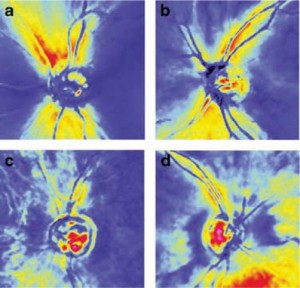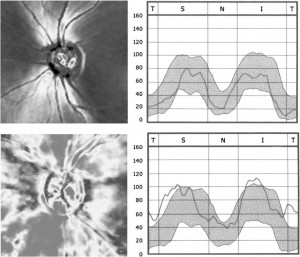Orlev A, Horani A, Rapson Y, Cohen MJ, Blumenthal EZ.
Eye (Lond). 2008 Nov;22(11):1378-83. Epub 2007 Jul 13.
Department of Ophthalmology, Hadassah-Hebrew University Medical Center, Jerusalem, Israel.
ABSTRACT:
PURPOSE: To characterize which clinical features are associated with the occurrence of atypical birefringence patterns (ABP) occasionally seen with scanning laser polarimetry (SLP).
METHODS: Sixty-one subjects, including glaucoma patients, glaucoma suspects, and normal subjects, underwent a full clinical examination, standard visual field (VF) test, and a GDx-VCC SLP examination. One eye was selected from each patient. The magnitude of ABP was determined in two independent ways: using a support vector machine analysis (typical scan score (TSS)) and by a masked experienced observer. We assessed whether the magnitude of ABP was correlated with age, gender, the refractive state of the eye, corneal polarization axis and magnitude, GDx global parameters (TSNIT and NFI), and the VF status, as evident from glaucoma hemifield test (GHT), mean deviation (MD), and the pattern standard deviation (PSD).
RESULTS: Of the 61 study eyes, 27 (44%) showed an ABP, based on a TSS cutoff (<82.5). A very high correlation was found between the TSS score and the masked experienced observer score (r(2)=0.80; P<0.001). The following clinical parameters were found, on bivariate analysis, to be significantly correlated with the presence of an ABP: age (r(2)=0.086; P=0.02); corneal polarization magnitude (r(2)=0.069; P=0.04); TSNIT (r(2)=0.16; P<0.001).
CONCLUSION: The presence and magnitude of ABP did not seem to be closely correlated with most clinical parameters. A low, but statistically significant, correlation was found for age and corneal polarization magnitude (r(2)=0.086 and 0.069, respectively). A low-medium correlation was found for TSNIT (r(2)=0.16); however, we speculate that this might represent a confounding effect, rather than an underlying association. We conclude that none of the clinical parameters investigated in this study appears to be strongly correlated with the presence of an ABP on SLP scans performed using the commercially available GDx-VCC.
Article as Full-Text PDF
Figures from this atricle:


